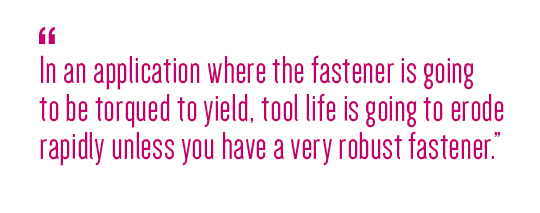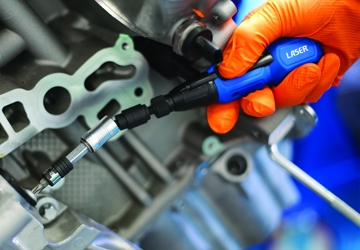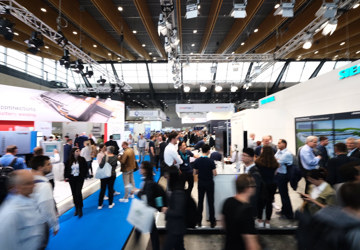

PART TWO
How about other sectors, for example rail or other wheeled vehicles?
“We see the truck sector move to new innovations because they are driven by the same fuel economy requirements – the lighter the cab, the engine, the transaxle, the more efficient getting cargo from A to B. There’s a lot going on at PACCAR Inc, KENWORTH, Peterbilt Motor Company, these kind of guys. Unity of design, lighter weight materials, all aimed at better optimised performance.
A great example of unity of design is Rolls Royce. Everything that comes out now is 100-degree flush head, MORTORQ® recess parts. All the truss heads coming off the Paccar assembly line have a PHILLIPS SQUARE-DRIV® combination drive. That means multi tool, multi drive, multi service capability in a lightweight package platform. You win efficiency savings in assembly that follow through into the aftermarket.
The ability to service an external MORTORQ® SUPER with a hex or 12- point socket in an emergency is a huge advantage. On the assembly line you have the efficiency of the optimal drive system paired in the aftermarket with the ability to do pretty well anything necessary to get it fixed.
In the industrial world, we’re now seeing the integration of optimised 3D technology into the design process driving more and more innovation. Instead of drawing in a 2D complex it can be pulled together from different places and integrated in the 3D modelling.
That means more flexibility. Occasionally you hit the issue of someone experienced in CAD but lacking shop floor knowledge. Then you get a design that is not easily capable of being manufactured but these things work themselves out and it’s part of the learning curve.”
So as automotive OEMs inevitably face a law of diminishing returns in terms of lightweighting where does MORTORQ® fit in?
“We talked about the process of lightweighting decisions. Don’t need to take it apart – glue it, friction stir weld, minimise addition of material. Got to open it, got to repair it, but still need to make it as light as I can but robust enough to be repairable? That’s where MORTORQ® comes into its own.
It has really proven its worth in the aerospace industry where we’ve taken large amounts of weight out of floorboard fasteners, which are the highest volume per airframe. The robust capability of damage tolerance in that particular system has lent itself very well to overhaul of the airframe in a much shorter time period.
We take that same philosophy and translate it into an automotive fastener as we did with Chrysler on their seats and we were able to minimise the seat track height, optimise the fastener driveability and yet serviceability is still straightforward.”
Where do you think Barton Coldform can score with MORTORQ?
“Barton’s ability to marry a couple of technologies to develop a thread forming fastener that can be driven at higher torque is extremely potent. In an application where the fastener is going to be torqued to yield, tool life is going to erode rapidly unless you have a very robust fastener. Either you create a system that has a higher limit than the yield of the fastener material, which is what we’ve done with the external MORTORQ® SUPER, or you start having line outages on a too frequent basis for it to be cost effective.
One study we’ve looked at with Barton Coldform suggests that by changing the fastener design they could take 25% of the weight out. On a high volume annual usage that is a massive saving.”

What next – different materials for the fasteners?
“You hear a lot about the austempered Grade 14.9 bolts that are around now. We’ve been in that arena for a long time with high strength titanium and high strength Inconel in the aerospace industry.
Yes, you can use fewer fasteners of a small diameter but the cost of that fastener goes up dramatically. Use ten fasteners at a dollar a piece to replace twenty at a quarter apiece and are you really getting a benefit?
You also risk compromising ductility for strength – and that becomes a real trade off forcing you to relook at the whole design. Take a 14.9 bolt and tighten it to the yield and you get face embedment and thread deformation because you are threading an ultra hard material into a cast steel or aluminium. So then you add a helicoil thread so you don’t strip out the block. All kind of design parameters start beginning to add up.
What looked like it was going to be a fairly linear trade off suddenly becomes multidimensional and really impacts overall cost.
My feeling is, when we look at dealing with high strength materials in automotive you are almost at the point of diminishing returns.





